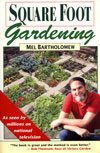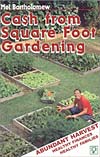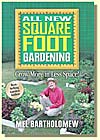Hello Everybody Naa ba nag try na sa Square Foot Gardening, Maayo ni siguro, wala pa ko kasuway ni pero im planning . Ang problem is yung
(Mel's Mix, a mixture of )
1/3 compost ----> madali lang ito
1/3 peat moss ------> ano kaya alternative nito.
1/3 coarse vermiculite (no dirt needed) ------> ano kaya alternative nito.
Square Foot Gardening is a uniquely simplified method of gardening that produces 100% of the harvest in only 20% of the space -- AND -- without all the hard work and drudgery of single row gardening.
[IMG]file:///C:/DOCUME%7E1/Robert/LOCALS%7E1/Temp/moz-screenshot.jpg[/IMG]
THIS SYSTEM WORKS FOR EVERYONE !
NO WEEDINGNO TILLING
NO DIGGING
Beginners and experts alike will enjoy this easy-to-learn, easy-to-do method.
IMPROVEMENTS OVER OTHER METHODSOut Produces Every Other Method KnownLargest Selling Garden Book In America, - EVER
- Requires very little space; 80% less than conventional gardening.
- Can be done in as little as 4 feet by 4 feet, -- or as large as you want.
- Your existing (bad) soil doesn't matter because we don't use it. Start with an ideal soil mix that is weed-free and requires no tilling.
- Uses much less water; only about 20% compared to conventional gardening.
- No fertilizers or pesticides to handle -- it's all natural
- The planting method requires no thinning and very few seeds.
- All the hard work has been removed in the Square Foot method - only the enjoyable part remains.
- Can be started in any season.
- Produces 5 times the harvest of a conventional garden.
- Can be done by those with physical or mental limitations. If getting down is a problem, raise the boxes to a wheelchair level.
- Makes a great family project, all ages can participate - kids love to garden.
First the locationPick an area that gets 6-8 hours of sunshine daily.

Stay clear of trees and shrubs where roots and shade may interfere.
Have it close to the house for convenience.
Existing soil is not really important, since
you won't be using it.
Area should not puddle after a heavy rain.
Then the Ten Basics
- LAYOUT - Arrange your garden in squares, not rows. Lay it out in 4'x4' planting areas.
- BOXES - Build boxes to hold a new soil mix above ground.
- AISLES - Space boxes 3' apart to form walking aisles.
- SOIL - Fill boxes with Mel's special soil mix: 1/3 blended compost, 1/3 peat moss, and 1/3 coarse vermiculite.
- GRID - Make a permanent square foot grid for the top of each box. A MUST!
- CARE - NEVER WALK ON YOUR GROWING SOIL. Tend your garden from the aisles.
- SELECT - Plant a different flower, vegetable, or herb crop in each square foot, using 1, 4, 9, or 16 plants per square foot.
- PLANT - Conserve seeds. Plant only a pinch (2 or 3 seeds) per hole. Place transplants in a slight saucer-shaped depression.
- WATER - Water by hand from a bucket of sun-warmed water.
- HARVEST - When you finish harvesting a square foot, add compost and replant it with a new and different crop.
What could be easier than this?
Build a box
Fill with Mel's Mix
Add a gridAnd start planting!Now the details
1 - LAYOUT. Always think in squares: lay out 4 foot by 4 foot planting areas with wide walkways between them.
2 - BOXES. Build garden box frames no wider than 4 feet, and 6 to 8 inches deep. The length is not as important, but a recommended size for your first time is one frame 4 foot by 4 foot. You can, of course, go smaller. A 2 foot by 2 foot works great on patios and 3 foot by 3 foot box is ideal for kids. Frames can be made from almost any material except treated wood, which has toxic chemicals that might leach into the soil. 1 by 6 or 2 by 6 lumber is ideal, and comes in 8-foot lengths. Most lumber yards will cut it in half at little or no cost. Exact dimensions are not critical. Deck screws work best to fasten the boards together. Rotate or alternate corners to end up with a square inside.
3 - AISLES. If you plan to have more than one garden box, separate them by 2 or 3 feet to form walkways.
4 - SOIL. Fill frame with Mel's Mix, a mixture of 1/3 compost, 1/3 peat moss, and 1/3 coarse vermiculite (no dirt needed). A blended compost made from many ingredients provides all the nutrients the plants require (no chemical fertilizers needed). Peat moss and vermiculite help hold moisture and keep the soil loose. It's best to make your own compost from many ingredients but if you have to buy it, make sure it is truly compost. Some stores sell mulch or humus and other ground covers but call it compost. Most commercial compost is made from one or two ingredients so to be safe, don't buy all of one kind but one of each kind until you have enough for your garden.
It's really best to make your own compost, then you know what goes in it. When buying vermiculite, be sure to get the coarse grade, and get the more economical 4 cubic foot size bags.
If placing frames over grass you can dig out the grass or cover it with cardboard or landscape cloth to discourage grass and weeds from coming up through your new garden soil.
5 - GRID. On top of each frame place a permanent grid that divides the box into one foot squares. The grid is the unique feature that makes the whole system work so well. To show you why the grid is so important, do this little demonstration: Look at your 4 foot by 4 foot box with the grid on and imagine up to 16 different crops. What you see before you is a neat and attractive, well organized garden, that will be easy to manage.
Now remove the grid. Could you organize and manage this space without dividing it up into squares? Besides, without the grid you will be tempted to plant in rows, which is a poor use of space.
Grids can be made from nearly any material; wood, plastic strips, old venetian blinds, etc. Use screws or rivets to attach them where they cross. On a 4 foot by 4 foot frame, the grid divides the frame into 16 easy-to-manage spaces, for up to 16 different crops. Leave the grid in place all season. The grid can be cut long enough to fit across the top of the box or cut shorter to lay on the soil inside the box.
6 - CARE. Since you will NEVER walk on or depress the growing soil, don't make the frames any wider than 4 feet (2 feet, if only one side is accessible). Any wider makes it too difficult to reach in to tend the plants.
7 - SELECT. Depending on the mature size of the plant, grow 1, 4, 9, or 16 equally spaced plants per square foot. If the seed packet recommends plant spacing be 12 inches apart, plant one plant per square foot. If 6 inch spacing; 4 per square foot. If 4 inch spacing; 9 per square foot. If 3 inch spacing; 16 per square foot.
8 - PLANT. Plant one or two seeds in each spot by making a shallow hole with your finger. Cover, but do not pack the soil. Thinning is all but eliminated. Seeds are not wasted. Extra seeds can be stored cool and dry in your refrigerator.
Don't over-plant. Plant only as much of any one crop as you will use. This 4 foot by 4 foot box will grow more than a conventional garden that is 8 foot by 10 foot.
9 - WATER. Water only as much as each plant needs. Water often, especially at first, and on very hot dry days, If possible, water by hand ( uses a lot less water )with a cup from a sun-warmed bucket of water. Warm water helps the soil warm up in early and late season.
10 - HARVEST. Harvest continually and when a crop in one square is gone, add some new compost and plant a new different crop in that square.
Free Handout
Official Website : www.squarefootgardening.com
Results 1 to 10 of 40
Thread: Square Foot Gardening
-
03-04-2009, 10:16 PM #1
 Square Foot Gardening
Square Foot Gardening
-
03-07-2009, 01:54 PM #2
-
03-09-2009, 12:40 PM #3
-
03-09-2009, 01:41 PM #4
I think I have done this before and I don't know this has a name now. The Internet sure have a way of spreading info so fast and so wide.
-
03-10-2009, 09:11 AM #5
-
03-18-2009, 10:34 PM #6
any body has done this?
-
03-18-2009, 10:38 PM #7
nice lage ni nga idea noh although wa lang ko kasabot sa last two kailangan sa mel's mix, ako ra nasabtan ang compost
-
04-10-2009, 01:15 AM #8
Mao Bitaw bai, ang akon gusto mahibaw-an kong asa ni paliton.. Kinsa pa diha naa idea...
Pero naa ako na search para sa Alternative sa Peat Moss
Save The Peat Moss! Switch To Coconut Coir
by: Ian

Hereís an interesting tip to help gardeners combat global warming: stop using peat moss and switch to coir, the fiber or hair from the outside of a coconut. Why is peat moss so valuable all of the sudden? Because peatlands take hundreds of years to naturally renew themselves, and they are a huge source for trapping carbon in the earth. Most peat moss comes from Canada, and recent studies by Michigan State and University of Laval have shown that the peatlands are in trouble, especially in Quebec. Currently, peat moss manufacturers are working on restoration projects to help bring the soil back to life, but many organic gardeners are giving up on peat moss completely, and instead choosing a more environmentally friendly option, like coconut coir. Itís actually much better than peat moss because it holds more water, drains better, takes longer to decompose, and of course it has a smaller carbon footprint. Make sure to pick up a brick of coconut coir next time youíre at your local garden shop.
its Called COCO PEAT..... So isa nalang.Last edited by inspector_ronan; 04-10-2009 at 01:41 AM.
-
04-11-2009, 10:00 AM #9
coco coir can be bought as a compressed brick sa ACE SM and Handyman Robinson & Emall. tag 35-40 ang brick which can expand to about 4 liters when wet.
As for coarse vermiculite alternatives would be perlite and pumice. Perlite is very light almost like styro but i dont know where this can be purchased. I remember buying this before sa mga hardware pero i havent seen them lately. Pumice is heavier and is sold in bags at the same hardware stores mentioned above.
@inspector, I have some extra pumice here, if you want you can have them.
-
04-15-2009, 03:51 AM #10
Advertisement
Similar Threads |
|










 Reply With Quote
Reply With Quote

 Ca$h From Square foot Gardening
Ca$h From Square foot Gardening

 Para ma start na. then Post ko here mga Pcture sa Project Gardening... when puwede makuha?
Para ma start na. then Post ko here mga Pcture sa Project Gardening... when puwede makuha? 
